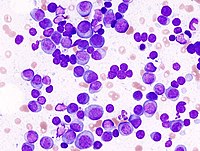
Photo from wikipedia
This work represents the first systematic speciation study of selenium (Se) in plasma from subjects participating in a pilot study for a cancer prevention trial (PRECISE). This involved supplementation of… Click to show full abstract
This work represents the first systematic speciation study of selenium (Se) in plasma from subjects participating in a pilot study for a cancer prevention trial (PRECISE). This involved supplementation of elderly British and Danish individuals with selenised yeast for 6 months and 5 years, respectively, at 100, 200, and 300 μg Se/day or placebo. Speciation data was obtained for male plasma using HPLC-ICP-MS and HPLC-ESI-MS/MS. With the proposed strategy, approximately 1.5 mL of plasma was needed to determine total Se concentration and the fractionation of Se in high molecular weight (HMW) and low molecular weight (LMW) pools, and for quantification and identification of small Se species. For the first time, Se-methyl-selenocysteine (MSC) and methyl-2-acetamido-2deoxy1-seleno-β-d-galactopyranoside (Selenosugar-1) were structurally confirmed in plasma after supplementation with selenised yeast within the studied range. Determination of selenomethionine (SeMet) incorporated non-specifically into albumin (SeALB) was achieved by HPLC-ICP-MS after hydrolysis. By subtracting this SeMet concentration from the total Se in the HMW pool, the concentration of Se incorporated into selenoproteins was calculated. Results from the speciation analysis of the free Se metabolite fraction (5% of total plasma Se) suggest a significant increase in the percentage of Se (as SeMet plus Selenosugar-1) of up to 80% of the total Se in the LMW fraction after 6 months of supplementation. The Se distribution in the HMW fraction reflects a significant increase in SeALB with Se depletion from selenoproteins, which occurs most significantly at doses of over 100 μg Se/day after 5 years. The results of this work will inform future trial design. Graphical abstract Graphical abstract
Journal Title: Analytical and Bioanalytical Chemistry
Year Published: 2020
Link to full text (if available)
Share on Social Media: Sign Up to like & get
recommendations!